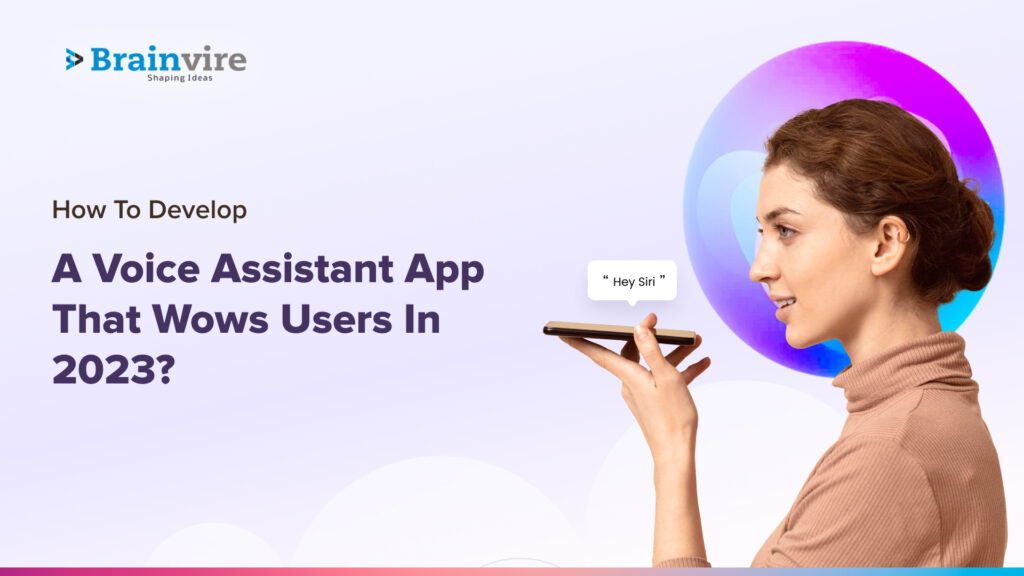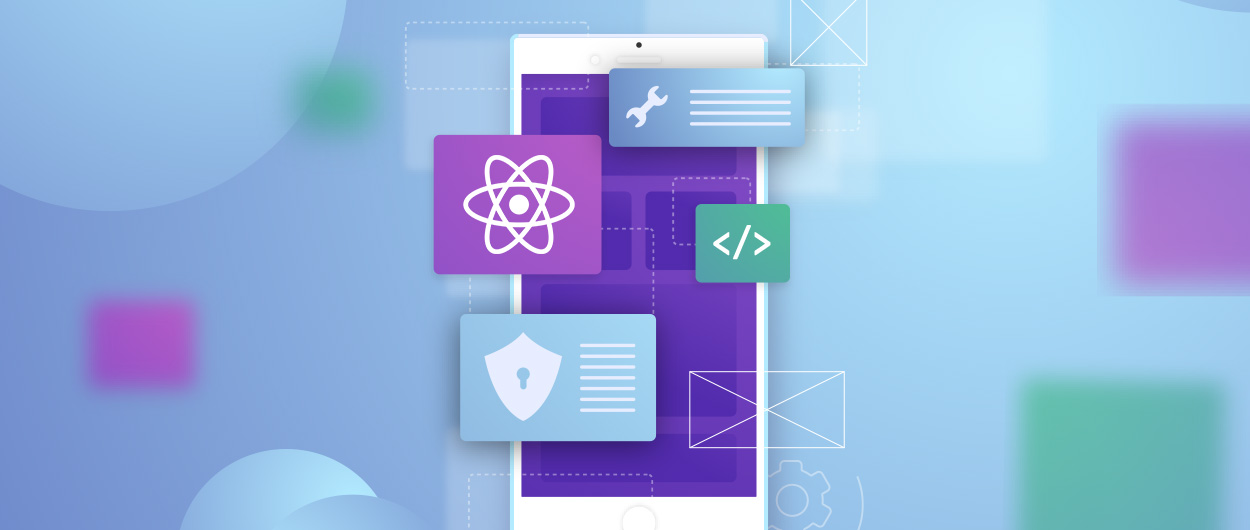The power of AI has been growing by leaps and bounds over the last few years! From automated operations to a simplified business approach, a noteworthy development can be noticed in the growing prevalence of mobile applications with voice assistance capabilities.
These applications have advanced capabilities that create a unique personalized experience between the device and the user. The voice assistant feature is designed to interpret the queries of its users and search for solutions accordingly.
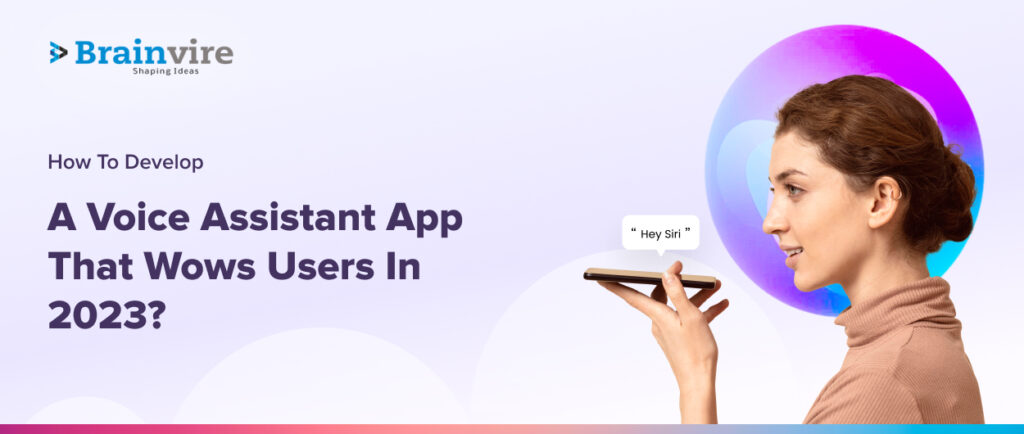
Interestingly, voice assistant use has already moved beyond mobile phones and is now making its way into eCommerce and online retail, among other businesses.
This blog teaches you the basics of developing an effective assistance voice app. So continue reading as we look into the steps involved in voice assistant app development that stands out in 2023.
The Race For Perfect Voice Assistant App!
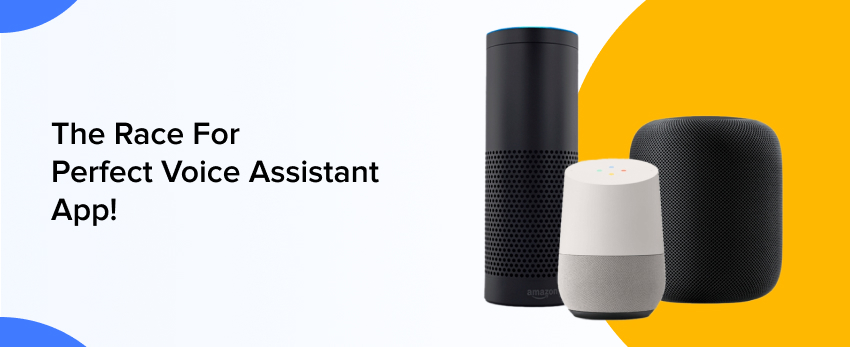
Multiple voice assistance apps strive to acquire the best virtual assistant app title. But unfortunately, only some of these existing applications fail to come at par with all user’s requirements.
Therefore, it is crucial for businesses to exert their utmost effort in creating the perfect voice assistant app that fulfills users’ specific needs and preferences. This is the only effective way to ensure your virtual assistant app is successful in the market.
Creating the ideal assistant voice app is easier than many might imagine. All you need to do is follow simple steps to get things done effectively. Here are some of the well-thought-out steps you need to remember to create the right voice assistant app in 2023.
Step 1: Understanding User Needs and Expectations
Understanding your target audience’s unique needs and expectations is the foundation for creating any mobile app on any interface. This is an important factor that can play a crucial role in determining the application’s success in the future. Therefore, it is common that understanding your customer’s needs and expectations is an essential consideration when creating a voice assistant app in 2023.
Follow Online Surveys Closely
You can get a nuanced idea of practical ways to generate better customer input in many ways. You can use online surveys and seek input from people about the specific features and functionalities they wish to have. This will give you a granular insight into what your customers want to see on their favorite voice assistant apps.

Target The Pain Points
Besides that, you can use other research tactics to understand better the issues people face with existing voice assistant apps. Once you have identified the problem then it will become much easier to address them. And create the right voice assistant app for users. However, test the hypothesis of these issues before integrating their solutions into the final product.
However, if you still need help with your voice assistant app development, check out some successful apps already existing in the market and simultaneously meet users’ expectations. Some of the best-known existing voice assistant apps that meet users’ requirements include Siri from Apple, Alexa from Amazon, and Google Assistant from Google, among many others.
So make sure you evaluate how these apps operate to get a better idea of what works for users of your voice assistant app.
Step 2: Choosing The Right Technology and Platform
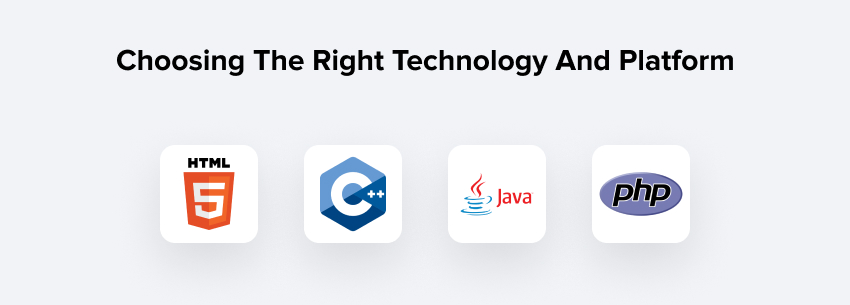
Once you have a nuanced idea of your user’s unique needs and expectations, it is time to move on to the next and one of the most important steps in creating a successful personal assistant app.
This is when you shift to finding the right technology and platform to facilitate successful mobile app development. This decision is not as easy as many might imagine since numerous mobile app development technologies and platforms are available.
Optimize Your Voice Assistant’s Core
For starters, you can use Swift to optimize your voice assistant app’s overall performance regardless of the use case. Besides that, Swift also offers a built-in error-handling mechanism designed to eliminate any coding error that might have gone unnoticed.
C++ is another popular programming language people use to develop mobile apps in today’s day and age. This technology allows you to develop applications that can adapt to multiple platforms.
Other than that, HTML5, Java, and PHP are among the most popular programming languages people can use to create voice assistant apps. These are tried and tested technologies as long as you can pick the right one based on your business’s and end-users specific requirements.
So if you are wondering how to develop an app with voice assistant capabilities, evaluate the offerings of these programming languages.
Pick An Existing Mobile App Development Technology
When on the quest to develop the best voice assistant app, it’s evident that you might get confused with the tons of development technology present on the platform.
You can make this decision easier by considering certain factors before picking any Android app development trends. It would help if you were mindful of many of these factors, including the security the technology offers and the cost of using a specific technology.
Besides that, you must also be certain about the competence level of your development teams to ensure they can make the most of its offerings. While at it, you must also evaluate if your chosen technology offers scalability, which will be a significant requirement for your business as you grow.
Once you are done evaluating the specific factors before choosing the right mobile app development technology, it is time to start with the simple pros and cons of different technologies. It is not surprising the different mobile app development technologies have certain pros and cons.
Therefore, you must evaluate every favorable technology and its pros and cons. This will make it easier for you to make the right choice in terms of choosing the ideal mobile app development tools for your voice assistant app.
Consider The Scalability Potential Of Your App

After you’ve successfully settled on an app development technology, it is time to thoroughly consider the scalability potential of the technology you choose. This might not appear as much of a concern in the initial stages but can become an important influencing factor.
Every business strives to scale its operations with time, and your voice assistant app needs to support that scalability when needed. Therefore, a technology stack with a reliable project structure is key to having a scalable voice assistant app. Experts recommend evaluating every aspect of your voice assistant app development plan based on the specific requirements of your business and voice assistant app.
After you have navigated all these challenges, your budget constraints are the final area of concern. Running a successful business means making the most of all the available resources.
Looking at the different aspects of choosing the right program, it’s evident that the overall process of voice assistant app development is the same since there are resource constraints on this front. Therefore, you must consider your tech stack’s overall cost and value to make a reasonable decision.
This is very important since you might decide to spend large sums on tools to facilitate faster voice assistant app development. However, this does not necessarily help you with customization needs which can soon become a significant drawback for your choice. You must pick the ideal tech stack that can work efficiently without burning a hole in your pockets. This will ensure your voice assistant app brings better value in the long run.
Step 3: Designing An Engaging User Interface
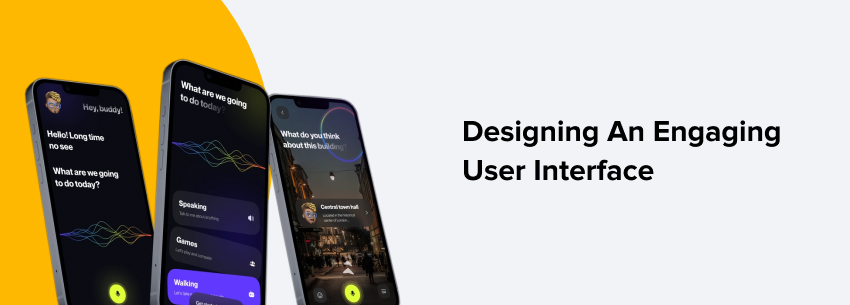
The user interface is one of the most important factors when creating a voice assistant app in 2023. Your voice assistant app’s overall usability and navigability are imperative to the application’s success. An optimally designed user interface leaves a lasting first impression on users, enticing them to explore the app further.
Aim Towards A Better UI
Another important factor that makes the user interface so important is that it makes it much easier to enhance the overall user experience to drive engagement. Most performant applications available in the market are known for offering amazing usability and accessibility.
Therefore, the best way to replicate this tried and tested strategy is to create the ideal user interface and build a compelling brand identity. Lastly, an optimal user interface also helps facilitate seamless updates and maintenance of your application.
Select The Right Interface Elements
The next area of focus here is the critical user interface elements you need to be mindful of when creating your voice assistant app. You need to take care of four different elements: navigational components, input controls, containers, and informational components. Each element serves different purposes in creating the ideal user interface for your voice assistant app.
For instance, your input controls will allow users to enter information into the system. Suppose your user needs to enter information about the country they live in; then, input controls will enable them to do this. Next comes the navigational components that help users move around within the app. Usually, these navigational components can be anything from tab bars to hamburger menus.
Pick The Right Informational Components
Besides that, you also have informational components that help users share information with other users. Lastly, the container elements will enable the application to hold related content together.
Therefore, when creating a successful assistant voice app, you must be mindful of these elements’ functionality. However, optimizing all these elements will yield only results if you can alter them based on the specific requirements of your users.
Understand The Need & Expectations Of Users
Every voice assistant app developer must fully understand their user’s needs and expectations when designing a user interface. You must start with determining your target audience and refer to the data you have generated from users in the first step of the process. However, consider getting into more granular details with surveys about specific user interface elements.
Nonetheless, your primary focus must be to prevent as many errors as possible and maintain thorough consistency throughout the user interface design. Many tend to go overboard with aesthetics and ignore functionality when designing the user interface.
On the contrary, there have also been cases when more focus remained on functionality while aesthetics failed to match industry standards. But it is essential to avoid such mistakes and strike the right balance between aesthetics and functionality of the user interface of your voice assistant app.
This means you can add certain aesthetic features to the interface as long as you ensure the change does not adversely impact the functionality. The same goes for functionality which is important to facilitate the seamless use of the voice assistant app. So make sure you keep both these elements in mind when creating a voice assistant app for your business.
Step 4: Developing The App
HAfter successfully creating a functional and visually appealing user interface, the next step is to commence the overall development process of the voice assistant app. This process begins with thorough research and careful planning, followed by the execution of the gathered insights into the application.
Besides that, this is also the phase when you need to single out the features. Other relevant elements you wish to eliminate from your voice assistant application. The simplest and most effective way to do this is to test your app during development rigorously.
Once you start testing your app, you will naturally encounter specific bugs in the initial stages. However, this does not mean you should be demotivated with these bugs but make efforts to address them. This is where debugging comes in as your excellent tool for getting rid of any bugs. Hampering the development of your voice assistant app.
This might be followed by a phase where you no longer encounter app bugs. But before celebrating your success, you must collaborate with other developers and stakeholders in the app development process. It is natural to make mistakes when developing mobile apps but collaborating with other experts and stakeholders can make it much easier to address these issues effectively. Besides, this will also help hasten the overall troubleshooting and debugging process for your voice assistant app development.
Step 5: Integrating Third-Party Services And APIs
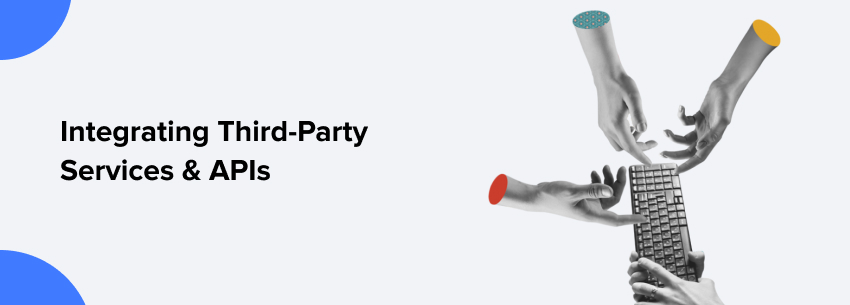
You can create a voice assistant app with third-party services and APIs in three ways. The first is the junior method, which integrates voice assistant technology with API integration. The second is the middle method, where you can build a voice assistant with open-source APIs and services. Lastly, the third method is the older method, where you build a voice assistant from scratch and integrate it into the voice assistant app.
Therefore, you must evaluate your requirements and competencies to choose the ideal method for integrating APIs and third-party services. With a competent team of developers, you can build your voice assistant from scratch using the third method. Additionally, you have the option to utilize the first method to streamline development or the second method to better cater to your specific requirements.
No matter which method you decide to utilize, integrating third-party apps and services can bring significant advantages to your voice assistant app. Integrating these APIs and third-party services helps you save time and money while facilitating more efficient deployment. Besides that, you can access more features with limited resource constraints with third-party API and service integration.
Apart from these advantages, certain concerns are associated with integrating third-party APIs and services in your voice assistant app. The primary concern on this front comes from data security and privacy when using these third-party APIs. Any breach in user data privacy or overall data security can drastically impact your business’s reputation. Therefore, take all the measures to ensure the third-party APIs you integrate do not cause any data breaches.
Step 6: Launching And Marketing The App

Now that you have a functional voice assistant app, it is time to prepare for the app launch. In marketing, the term “pre-launch” refers to the timeframe immediately preceding the app’s official launch.
This is the phase where you need to beta-test the app while refining and optimizing it as far as possible. This will help you get better app rankings on respective platforms allowing you to attract more customers with minimal effort.
After concluding the entire pre-launch phase, it is time to focus on using social media channels to spread the word around. Over the years, social media has become a highly lucrative tool to promote businesses and their offerings.
You can use these marketing tactics to increase engagement and reach the right customers and users. You can even organize content on different social media channels to generate amplified awareness and increase app downloads.
Now that you have launched your app, it is time to see how the market and your target audience react. The best and most accountable way to do this is by tracking and analyzing app metrics following the launch. You can even watch for constructive feedback and use this data to enhance your app. Besides that, these metrics will give you a first-hand idea of what works best for your target audience.
Conclusion
Assistant voice apps are becoming highly popular with each passing year. And more people are now drawn toward this convenient functionality. Hence building a voice assistant app is one of the best things you can do to facilitate better business growth.
However, this process is complex and as rewarding as it is since many factors need to work in tandem to get things right. So refer to the information above and make this entire ordeal easier.
FAQs
Voice assistant apps are application programs equipped with capabilities to comprehend natural language voice commands and complete a specific task. Siri from Apple and Google Assistant are common examples of voice assistant apps.
Voice assistant apps offer numerous advantages. Such as enabling users to control smart home devices, receive live news and weather updates, access translations, play media, and more.
A voice assistant app provides versatile functionality for users, including instant voice commands, query resolution, media playback, and email sending. Additionally, it enables efficient management of to-do lists and seamless control of smart home devices.
The cost of developing a voice assistant app can vary based on multiple factors. However, in most cases, these costs can either increase or decrease based on the unique requirements of your business. Some businesses require limited features while others require more, directly influencing the price.
There are many such cases where outsourcing voice assistant app development has benefited businesses. Outsourcing enables cost-effective solutions, expert insights, efficient deployment, and a wider talent pool for development and growth.
Related Articles
-
Building Your First React Native App: A Step-by-Step Guide
It’s a thrilling trip to start developing your first React Native application. This detailed guide is intended to serve as your compass, guiding you through the procedure in an understandable
-
Improving Mobile Application Development – Tips For Business Apps
Building a mobile application for your business is a good start. Embracing new technology and futuristic mobile solutions could be your first step into the future that definitely will be
-
How Beacons Are Modernizing The Mall Space?
Talking About How Beacons Are Modernizing The Mall Space? Drawing more footfall, increasing conversion ratio and up surging the sales is the uphill battle for the malls! The struggle to

